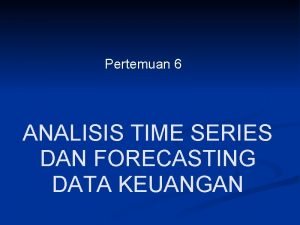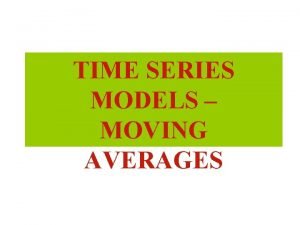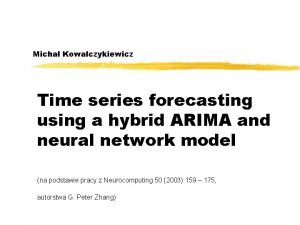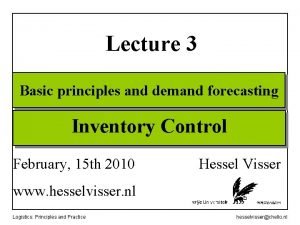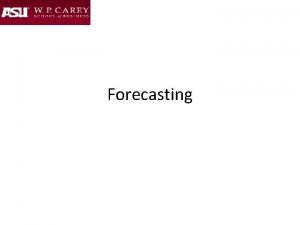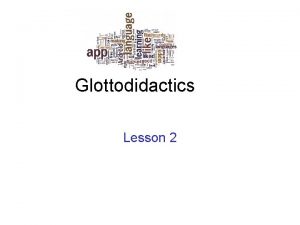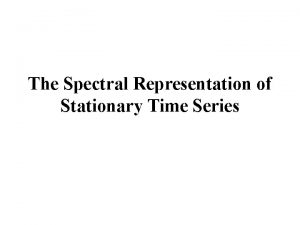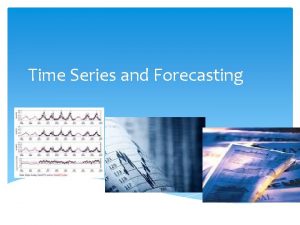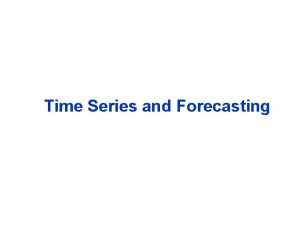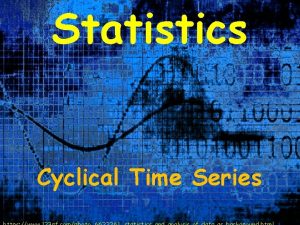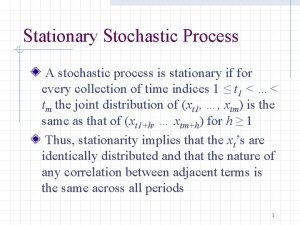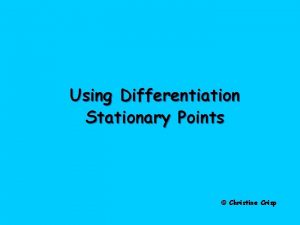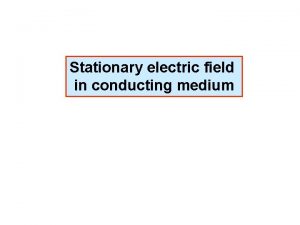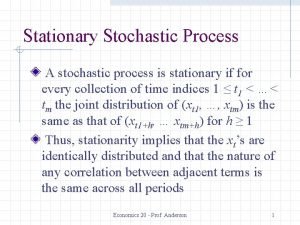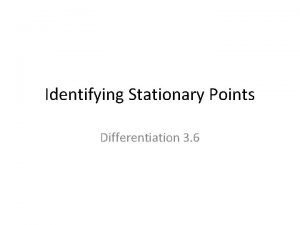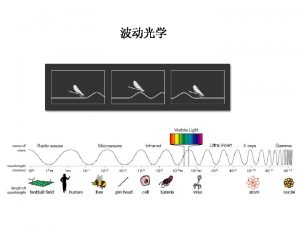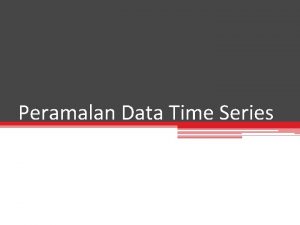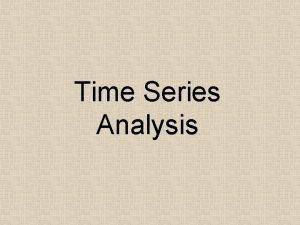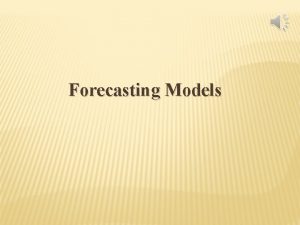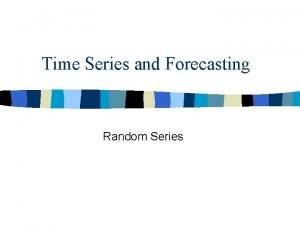LESSON 5 FORECASTING STATIONARY TIME SERIES METHODS Outline
























- Slides: 24

LESSON 5: FORECASTING STATIONARY TIME SERIES METHODS Outline • • Simple Moving Average Weighted Moving Average Exponential Smoothing Comparison of Simple Moving Average and Exponential Smoothing

Time Series Methods • In this lesson we shall discuss some time series forecasting methods. All methods discussed in this lesson are designed for stationary series. Recall from the previous lesson that a stationary series contains only the average and no trend, seasonality, cyclicity, etc. • No method is superior to any other method in every context. In a particular context, various methods can be used and evaluated using a suitable measure (e. g. , MAD, MSE, MAPE etc. ) discussed in the previous lesson. Then, it is possible to use the method that works best in that context. See the Taco Bell example. • A comparison among the methods is done near the end of the lesson.

Time Series Methods • All these methods will be illustrated with the following example: Suppose that a hospital would like to forecast the number of patients arrival from the following historical data: Week Patients Arrival 1 400 2 380 3 411 4 415 • Note: Although week 4 data is given, some methods require that forecast for period 4 is first computed before computing forecast for period 5.

Time Series Methods Simple Moving Average 450 — Patient arrivals 430 — A moving average of order N is simply the arithmetic average of the most recent N observations. For 3 -week moving averages N=3; for 6 -week moving averages N=6; etc. 410 — 390 — 370 — 0 Actual patient arrivals | 5 | 10 | 15 Week | 20 | 25 | 30

Time Series Methods Simple Moving Average 450 — Patient arrivals 430 — 410 — 390 — 370 — 0 | 5 Week Patient Arrivals 1 2 3 400 380 411 Given 3 -week data, one-step-ahead forecast for week 4 or two-step-ahead forecast for week 5 is simply the arithmetic average of the first 3 -week data | 10 | 15 Week | 20 | 25 | 30

Time Series Methods Simple Moving Average 450 — Patient arrivals 430 — 410 — Week Patient Arrivals 1 2 3 400 380 411 390 — 370 — 0 | 5 | 10 | 15 Week | 20 | 25 | 30

Time Series Methods Simple Moving Average 450 — Patient arrivals 430 — 410 — Week Patient Arrivals 1 2 3 400 380 411 390 — 370 — 0 | 5 | 10 | 15 Week | 20 | 25 | 30

Time Series Methods Simple Moving Average 450 — One-step-ahead forecast for week 5 is computed from the arithmetic average of weeks 2, 3 and 4 data Patient arrivals 430 — 410 — Week Arrivals 2 3 4 380 411 415 390 — 370 — 0 | 5 | 10 | 15 Week | 20 | 25 | 30

Time Series Methods Simple Moving Average 450 — 3 -week MA forecast Patient arrivals 430 — 410 — 390 — 370 — 0 Actual patient arrivals | 5 | 10 | 15 Week | 20 | 25 | 30

Time Series Methods Simple Moving Average 450 — 6 -week MA forecast 3 -week MA forecast Patient arrivals 430 — 410 — 390 — 370 — 0 Actual patient arrivals | 5 | 10 | 15 Week | 20 | 25 | 30

Taco Bell determined that the demand for each 15 -minute interval can be estimated from a 6 -week simple moving average of sales. The forecast was used to determine the number of employees needed.

Time Series Methods Weighted Moving Average In the simple moving average method each of the N periods is equally important for the purpose of forecasting. Weighted moving average is more general than the simple moving average and assigns different weights to different periods. Let, Then, the one-step ahead forecast for period t

Time Series Methods Weighted Moving Average 450 — 3 -week MA forecast Weighted Moving Average Assigned weights Patient arrivals 430 — t-1 t-2 t-3 410 — 0. 70 0. 20 0. 10 390 — 370 — 0 | 5 | 10 | 15 Week | 20 | 25 | 30

Time Series Methods Weighted Moving Average 450 — 3 -week MA forecast Weighted Moving Average Assigned weights Patient arrivals 430 — t-1 t-2 t-3 410 — 0. 70 0. 20 0. 10 390 — 370 — 0 | 5 | 10 | 15 Week | 20 | 25 | 30

Time Series Methods Exponential Smoothing • Exponential smoothing method computes a forecast value which is the weighted average of the most recent data and forecast values. • The weight assigned to the most recent data is called the smoothing constant, and the weight assigned to the most recent forecast is (1 - ). • The method requires an initial forecast value. The initial forecast value may be obtained by some other forecasting technique. • If the smoothing constant, is large, the forecast values fluctuate with the actual data. If is small, the fluctuation is less.

Time Series Methods Exponential Smoothing • The one-step-ahead forecast for period t • Notice that therefore, • With further expansion of the expression forecast for period t it can be seen that the forecast for period t depends on all previous data!!

Time Series Methods Exponential Smoothing Patient arrivals 450 — 430 — Exponential Smoothing = 0. 10 410 — Ft = Dt-1 + (1 - )Ft - 1 390 — 370 — 0 | 5 | 10 | 15 Week | 20 | 25 | 30

Time Series Methods Exponential Smoothing Patient arrivals 450 — 430 — Exponential Smoothing = 0. 10 410 — Ft = Dt-1 + (1 - )Ft - 1 Initial forecast value F 3 = (400 + 380)/2=390 D 3 = 411 390 — 370 — 0 | 5 | 10 | 15 Week | 20 | 25 | 30

Time Series Methods Exponential Smoothing Patient arrivals 450 — 430 — Exponential Smoothing = 0. 10 410 — Ft = Dt-1 + (1 - )Ft - 1 Initial forecast value F 3 = (400 + 380)/2=390 D 3 = 411 390 — 370 — 0 | 5 | 10 | 15 Week | 20 | 25 | 30

Time Series Methods Exponential Smoothing Patient arrivals 450 — 430 — Exponential Smoothing = 0. 10 410 — Ft = Dt + (1 - )Ft - 1 390 — F 4 = 392. 1 D 4 = 415 370 — 0 | 5 | 10 | 15 Week | 20 | 25 | 30

Time Series Methods Exponential Smoothing 450 — Patient arrivals 430 — 410 — 390 — 370 — 0 | 5 | 10 | 15 Week | 20 | 25 | 30

Comparison of Exponential Smoothing and Simple Moving Average • Both Methods – Are designed for stationary demand – Require a single parameter – Lag behind a trend, if one exists – Have the same distribution of forecast error if

Comparison of Exponential Smoothing and Simple Moving Average • Moving average uses only the last N periods data, exponential smoothing uses all data • Exponential smoothing uses less memory and requires fewer steps of computation; store only the most recent forecast!

READING AND EXERCISES Lesson 5 Reading: Section 2. 7, pp. 66 -77 (4 th Ed. ), pp. 63 -73 (5 th Ed. ) Exercises: 17, 18, 24, pp. 69, 75 -76 (4 th Ed. ), pp. 66, 72 (5 th Ed. )
 Contoh analisis time series laporan keuangan
Contoh analisis time series laporan keuangan Centered moving average
Centered moving average Time series forecasting
Time series forecasting Statistical methods of demand forecasting
Statistical methods of demand forecasting Statistical methods of demand forecasting
Statistical methods of demand forecasting Forecasting in operations management
Forecasting in operations management Contoh perencanaan dan peramalan keuangan
Contoh perencanaan dan peramalan keuangan Demand estimation
Demand estimation Arithmetic regression method for population forecasting
Arithmetic regression method for population forecasting Buston formula for fire demand
Buston formula for fire demand Wml logistics tracking
Wml logistics tracking Qualitative forecasting methods
Qualitative forecasting methods Lesson outline lesson 3 describing circuits answers
Lesson outline lesson 3 describing circuits answers Mountain building
Mountain building Lesson outline lesson 2 aquatic ecosystems answer key
Lesson outline lesson 2 aquatic ecosystems answer key Weather forecast lesson 3 outline answers
Weather forecast lesson 3 outline answers Lesson 2 physical properties answer key
Lesson 2 physical properties answer key The science duo physical and chemical changes
The science duo physical and chemical changes Climates of earth lesson 1 answer key
Climates of earth lesson 1 answer key Lesson outline case study lesson 3
Lesson outline case study lesson 3 Lesson 2 measurement and scientific tools answer key
Lesson 2 measurement and scientific tools answer key Unit 1 lesson 1
Unit 1 lesson 1 Lesson 2 muscle storyboard
Lesson 2 muscle storyboard Lesson outline lesson 2 wave properties answer key
Lesson outline lesson 2 wave properties answer key Magnets and magnetic fields lesson 1 answer key
Magnets and magnetic fields lesson 1 answer key
